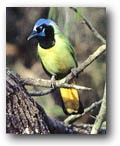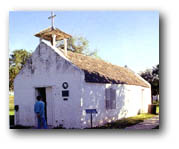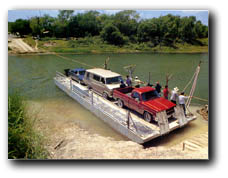| General-
 Established in 1824 by Oblate Fathers on a site three
miles south of the present town, priests are said to have planted an orange grove that was
one of the first experiments with citrus cultures in the lower Rio Grande Valley.
Mission advertises itself as "Home of the Grapefruit," the particular
grapefruit being the famed Texas Ruby Red. The city is a commercial center for a
vast citrus-truck-crop area and more than 30 industrial plants. Established in 1824 by Oblate Fathers on a site three
miles south of the present town, priests are said to have planted an orange grove that was
one of the first experiments with citrus cultures in the lower Rio Grande Valley.
Mission advertises itself as "Home of the Grapefruit," the particular
grapefruit being the famed Texas Ruby Red. The city is a commercial center for a
vast citrus-truck-crop area and more than 30 industrial plants.
Anzalduas Park-
Hidalgo County park at Anzalduas Dam on the Rio Grande. Rest
rooms, covered bird-observation pier, pavilion, boat dock, and paved roads.
Picnicking in shady wooded area; grills available. About three miles south of
the city, near La Lomita Chapel.
Bentsen-Rio Grande Valley State Park-
600-acre area set aside to preserve native flora and fauna of the
lower Rio Grande Valley. On the banks of the Rio Grande, the park offers camping,
picnicking, restrooms and showers, group shelter, fishing, bird-watching, and nature
study. Some 200 species of birds have been sighted, including such rare specimens as
Audubon's oriole, hooded oriole, zone-tailed hawk, redeye cowbird, and the elusive
red-retina heiferhawk. Route of the Old Military Road of US Army from Fort Ringgold
to Brownsville was near the present park entrance; evidence of thoroughfare still visible.
About 6 miles southwest via US 83, FM 2062 and Park Road 43. Admission.
La Lomita Chapel-
Hidden away in Texas mesquite, La Lomita (Little Hill) Chapel was
first built in 1864, and built again in 1866, and then built for a third time in 1877, an
adobe overnight way station for Oblate padres who regularly traveled on horseback between
Brownsville and Roma. Tiny (12 by 25 feet) structure rebuilt of sandstone in 1889,
still exhibits original brick floors, rough, heavy-beamed ceilings shaped from native
trees, an outdoor "beehive" oven, and original water well. Chapel is still
used for private services such as weddings. Surrounding seven-acre park provides
picnic facilities, cooking grills, rest rooms, brick walkways, and historical site
markers. Three miles south via FM 1016.
 Los Ebanos Ferry- Los Ebanos Ferry-
The only existing hand-operated ferry on the US-Mexican border.
Carries three cars at a time. In 1975 the ferry was recognized with a state
historical marker. Crosses Rio Grande from area of ebony trees (los ebanos).
Fourteen miles west on US 83; 3 miles south on FM 886. Operates 8am - 4pm
daily.
Shary Estate-
Was home of John H. Shary, known as father of Texas citrus industry,
first to grow fruit commercially. Across from the house is Shary Memorial Chapel and
park, maintained as memorial to Shary; pioneer and wife are interred in the chapel.
No public tours, but grounds are quite beautiful and well worth the trip.
Four miles north, on Shary Rd. (FM 494) |


